
The Large red damselfly, Pyrrhosoma nymphula, is a species of damselflies belonging to the family Coenagrionidae.

The white-legged damselfly or blue featherleg is a damselfly of slow-flowing, muddy waters. It occurs from the Atlantic to Siberia and is often abundant throughout its range.
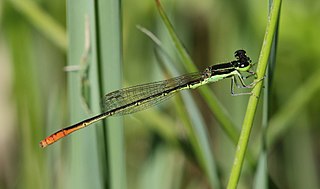
Agriocnemis pinheyi is a species of damselfly in the family Coenagrionidae. It is found in Mozambique, South Africa, Tanzania, Zambia, Zimbabwe, and possibly Malawi.
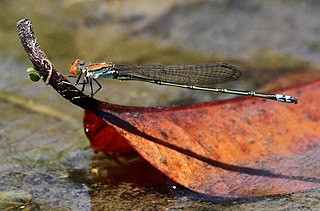
Pseudagrion acaciae, the acacia sprite is a species of damselfly in the family Coenagrionidae. It is found in Angola, Botswana, the Democratic Republic of the Congo, Malawi, Mozambique, Namibia, South Africa, Tanzania, Zambia, and Zimbabwe. Its natural habitats are subtropical or tropical rivers and floodplains.

Pseudagrion is the largest genus of damselfly in the family Coenagrionidae, with over 140 species. Its range includes most of Africa, much of Asia, and Australia. Africa holds most of the diversity with almost 100 species. It has occupied most of the freshwater habitats in its range, and dominates damselfly communities in habitats as different as desert pools, equatorial rainforests and montane streams.

Pseudagrion newtoni, the harlequin sprite, is a species of damselfly in the family Coenagrionidae.

Pseudagrion sublacteum or cherry-eye sprite is a species of damselfly in the family Coenagrionidae. It is found in Africa from northern South Africa to West and North Africa, and in the Middle East.
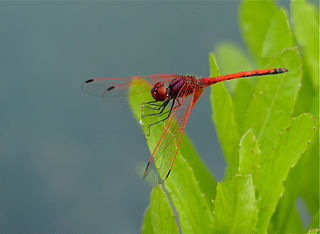
Trithemis arteriosa, the red-veined dropwing, is a species of dragonfly in the family Libellulidae.

The gold-fronted riverdamsel is a damselfly species in the family Coenagrionidae. Its body length is 36 millimeters. They are also known as gold-fronted sprites. Gold-fronted riverdamsels can be found near running or still water. They usually fly close to the surface of water, sometimes resting on floating material. They may not be as abundant as their relative the blue riverdamsel, but they are easily recognized by their golden-yellow faces and thorax. Its status is fairly common. They can be found cruising above the water on sunny days along slow-flowing sections of creeks.

The blue riverdamsel, Pseudagrion microcephalum is a common species of damselfly in the family Coenagrionidae. It is also known as the blue sprite and blue grass dart.

Pseudagrion caffrum, the springwater sprite is a species of damselfly in the family Coenagrionidae. It is found in Lesotho, South Africa and Swaziland. Its natural habitats include montane streams with grassy banks.
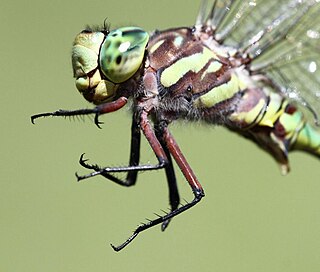
Pinheyschna subpupillata, the stream hawker, is a species of dragonfly in the family Aeshnidae.

Proischnura rotundipennis, the round-winged bluet is a species of damselfly in the family Coenagrionidae. It is endemic to South Africa, where it is scarce and localised.
Proischnura polychromatica, the mauve bluet, is a small species of damselfly in the family Coenagrionidae. It is endemic to a small area of Cape Province in South Africa. The adult male has a mauve sheen to its dark-coloured body, a bronze-green thorax striped with mauve, and a pale brown abdomen with a bronze-green dorsal stripe. The female is mainly pale brown. The natural habitat of this damselfly is transient pools in stream beds with floating vegetation, especially sedges. Although previously more widespread, it is now known from a single location where it is threatened by the encroachment of cattle and the loss of suitable habitat. For these reasons, the International Union for Conservation of Nature has rated it as "endangered".

Paracercion malayanum, Malay lillysquatter, is a species of damselfly in the family Coenagrionidae. It is known to occur in India, Sri Lanka, Nepal, Java, Philippines and Thailand.

Pseudagrion malabaricum, Malabar sprite, jungle grass dart, is a species of damselfly in the family Coenagrionidae. It is found in India, Sri Lanka, and Myanmar.

Pseudagrion rubriceps, saffron-faced blue dart, is a species of damselfly in the family Coenagrionidae. It is found in many tropical Asian countries.
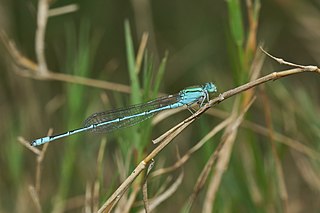
Pseudagrion decorum, elegant sprite or three striped blue dart, is a species of damselfly in the family Coenagrionidae. It is found in many tropical Asian countries.

Pseudagrion draconis is a species of damselfly in the family Coenagrionidae. It is commonly known as the mountain sprite.

Pseudagrion makabusiense, the green-striped sprite or Makabusi sprite, is a species of damselfly in the family Coenagrionidae.
























